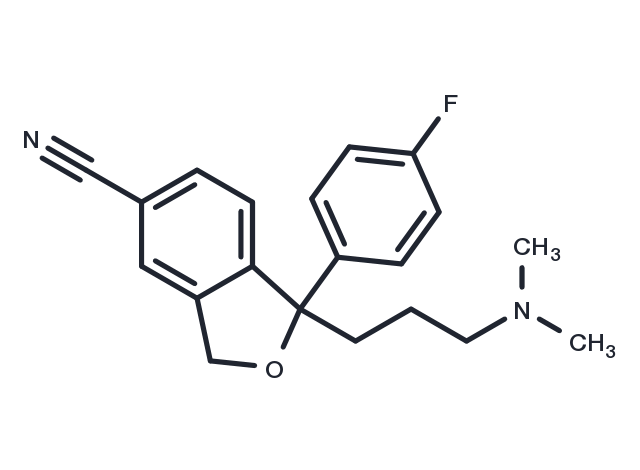Powder: -20°C for 3 years | In solvent: -80°C for 1 year


Citalopram (Lu 10-171 is an orally active, selective serotonin reuptake inhibitor (SSRI), a selective 5-hydroxytryptamine reuptake inhibitor, and a racemic mixture of the S(+)-enantiomer (Escitalopram) and the R(-)-enantiomer.Citalopram exhibits antidepressant activity and enhances serotonergic neurotransmission. It can be used to study Alzheimer's disease.

| Pack Size | Availability | Price/USD | Quantity |
|---|---|---|---|
| 25 mg | In stock | $ 30.00 | |
| 50 mg | In stock | $ 41.00 | |
| 100 mg | In stock | $ 64.00 | |
| 500 mg | In stock | $ 153.00 | |
| 1 mL * 10 mM (in DMSO) | In stock | $ 46.00 |

| Description | Citalopram (Lu 10-171 is an orally active, selective serotonin reuptake inhibitor (SSRI), a selective 5-hydroxytryptamine reuptake inhibitor, and a racemic mixture of the S(+)-enantiomer (Escitalopram) and the R(-)-enantiomer.Citalopram exhibits antidepressant activity and enhances serotonergic neurotransmission. It can be used to study Alzheimer's disease. |
| In vitro | Citalopram exhibits concentration-dependent cytotoxicity when applied at concentrations ranging from 25 to 175 μM for 24 hours[4]. Specifically, at a concentration of 100 μM for 24 hours, Citalopram strongly downregulates the expression of MYBL2, BIRC5, BARD1, AURKA, CCNA2, and CCNE1 in B104 cells[4]. |
| In vivo | Administered via intraperitoneal injection at doses ranging from 5 to 40 mg/kg, Citalopram reduces immobility time in DBA/2J mice but does not elicit a similar effect in C57BL/6J mice[3]. |
| Synonyms | Cipram, Lu 10-171, Lu-10-171 Lu10-171 |
| Molecular Weight | 324.39 |
| Formula | C20H21FN2O |
| CAS No. | 59729-33-8 |
Powder: -20°C for 3 years | In solvent: -80°C for 1 year
DMSO: 80 mg/mL(246.62 mM), Sonication is recommended.
You can also refer to dose conversion for different animals. More
bottom
Please see Inhibitor Handling Instructions for more frequently ask questions. Topics include: how to prepare stock solutions, how to store products, and cautions on cell-based assays & animal experiments, etc.
Citalopram 59729-33-8 GPCR/G Protein Neuroscience 5-HT Receptor Cipram Lu 10-171 Lu-10-171 Lu10-171 inhibitor inhibit
